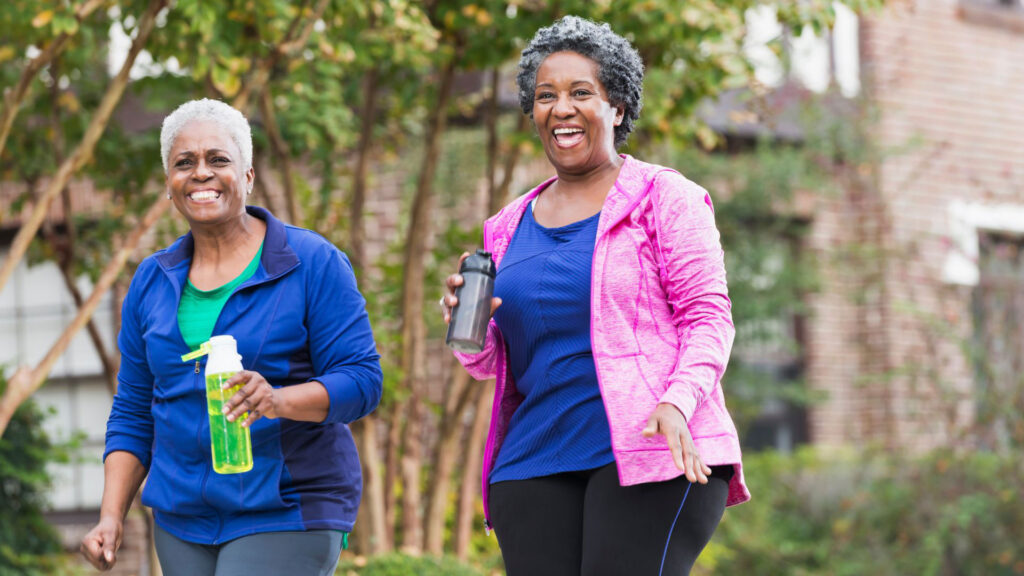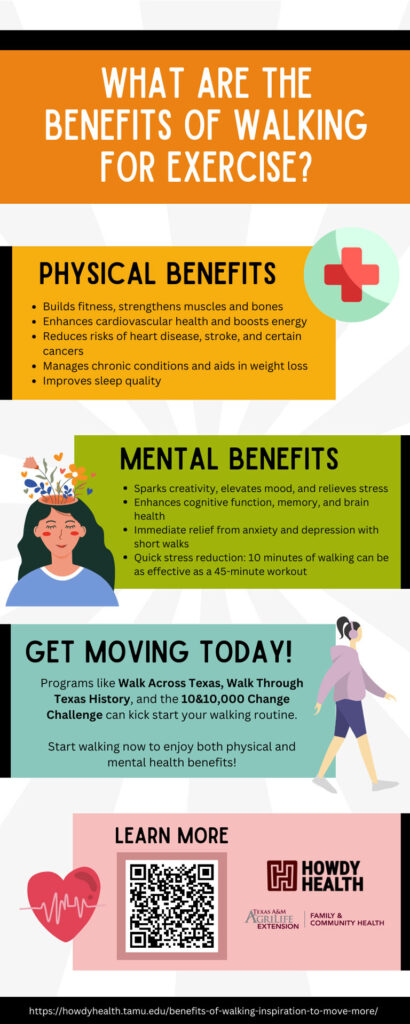Walking for exercise has some amazing health benefits! In fact, studies have shown that walking has the potential for both physical and mental health benefits. Although research is ongoing about the exact frequency, duration, and intensity needed to gain the most benefits, research on walking has demonstrated a myriad of potential physical and mental health benefits.
Physical Health Benefits of Walking
According to research, walking for exercise can result in:
- Increased physical fitness, including strengthening muscle and bones, increasing endurance, and improving balance1
- Increased energy levels and reduced fatigue2
- Increased cardiovascular and pulmonary (heart and lung) fitness 1
- Reduced risk of disease, including
- heart disease3,4
- stroke5,6
- some cancers7,8
- Reduced risk and/or improved management of chronic conditions, including
- high blood pressure9,10
- high cholesterol9,10
- diabetes10
- heart disease4
- joint and muscular pain and stiffness11,12
- Reduced body fat2,9
- Improved sleep quantity and quality.13,14
Mental Health Benefits of Walking
In addition to the physical health benefits, scientists are starting to uncover many mental health and cognitive benefits of walking for exercise. According to the Mental Health Foundation, people with physical health problems are at a significantly higher risk of developing mental health issues—and the reverse is also true. Nearly one in three people with a long-term physical health condition also experience a mental health condition, most often depression or anxiety.15 Walking can help:
- Boost mood, which could include
- increased joy, enthusiasm, excitement, interest, or alertness.15,16
- reduced negative “ruminating” thoughts of self (especially if walking outside in nature)18
- Increase creativity17
- Increase blood flow to the brain, which may optimize brain function, and an overall sense of wellbeing during exercise19
- Reduce risk of cognitive impairment, including
- Improving memory20
- Preventing the deterioration of brain tissue as we age21
- Relieve anxiety and depression.9,22
Noteworthy…
Some of the mental health benefits from walking may have a more immediate effect, which can be a great motivator to move more.
According to the Anxiety and Depression Association of America, research suggests that even brief bouts of physical activity – such as a 10-minute walk – can help reduce symptoms of anxiety and depression, producing effects comparable to those of longer exercise sessions. Regular aerobic exercise has also been linked to reduced tension, stabilized mood, improved sleep, enhanced self-esteem, and noticeable anti-anxiety effects that can begin within just a few minutes. Even a brisk walk or other simple activity can offer temporary relief from feelings of anxiety or depression, providing several hours of improvement.23
These immediate effects may be just what you need to sit less and move more!
Start your walking routine today. Join Walk Across Texas, Walk Through Texas History, or the 10-10,000 Challenge.
Infographic
Download the PDF or share the image below to help others learn about the benefits of walking for exercise.
References
- Garber CE, Blissmer B, Deschenes MR, Franklin BA, Lamonte MJ, Lee IM, Nieman DC, Swain DP; American College of Sports Medicine. American College of Sports Medicine position stand. Quantity and quality of exercise for developing and maintaining cardiorespiratory, musculoskeletal, and neuromotor fitness in apparently healthy adults: guidance for prescribing exercise. Med Sci Sports Exerc. 2011 Jul; 43(7): 1334-59. doi: https://doi.org/10.1249/MSS.0b013e318213fefb.
- Wender CLA, Manninen M, O’Connor PJ. The effect of chronic exercise on energy and fatigue states: A systematic review and meta-analysis of randomized trials. Front Psychol. 2022;13:907637. doi:10.3389/fpsyg.2022.907637.
- Sheng M, Yang J, Bao M, Chen T, Cai R, Zhang N, Chen H, Liu M, Wu X, Zhang B, Liu Y, Chao J. The relationship between step count and all-cause mortality and cardiovascular events: A dose-response meta-analysis. Journal of Sport and Health Science. December 2021 10(6):620-628. doi: https://doi.org/10.1016/j.jshs.2021.09.004.
- Hamer M, Chida Walking and primary prevention: a meta-analysis of prospective cohort studies. Br J Sports Med 2008;42:238–43. doi: https://doi.org/10.1136/bjsm.2007.039974.
- Hu FB, Stampfer MJ, Colditz GA, Ascherio A, Rexrode KM, Willett WC, Manson JE. Physical activity and risk of stroke in women. JAMA. 2000 Jun 14;283(22):2961-7. doi: https://doi.org/1001/jama.283.22.2961.
- Jefferis BJ, Whincup PH, Papacosta O, Wannamethee SG. Protective effect of time spent walking on risk of stroke in older men. Stroke, January 2014; 45(1)- 194-199. doi: https://1161/STROKEAHA.113.002246.
- National Institutes of Health. Physical activity linked to reduced cancer risk. July 2016. https://newsinhealth.nih.gov/2016/07/physical-activity-linked-reduced-cancer-risk.
- Saint-Maurice PF, Troiano RP, Bassett DR, et al. Association of Daily Step Count and Step Intensity With Mortality Among US Adults. 2020;323(12):1151–1160. doi: https://doi.org/10.1001/jama.2020.1382.
- Hanson S, Jones A. Is there evidence that walking groups have health benefits? A systematic review and meta-analysis. British Journal of Sports Medicine 2015;49:710-715.
- Williams PT, Thompson PD. Walking versus running for hypertension, cholesterol, and diabetes mellitus risk reduction. Arterioscler Thromb Vasc Biol. 2013 May;33(5):1085-91. doi: https://1161/ATVBAHA.112.300878.
- Lo GH, Vinod S, Richard MJ, Harkey MS, McAlindon TE, Kriska AM, Rockette-Wagner B, Eaton CB, Hochberg MC, Jackson RD, Kwoh CK, Nevitt MC, Driban JB. Association Between Walking for Exercise and Symptomatic and Structural Progression in Individuals with Knee Osteoarthritis: Data from the Osteoarthritis Initiative Cohort. Arthritis Rheumatol. 2022 Jun 8. doi: https://doi.org/10.1002/art.42241.
- Guglielmo D, Murphy LB, Theis KA, Boring MA, Helmick CG, Watson KB, Duca LM, Odom EL, Liu Y, Croft JB. Walking and Other Common Physical Activities Among Adults with Arthritis – United States, 2019. MMWR Morb Mortal Wkly Rep. 2021 Oct 8;70(40):1408-1414. doi: 10.15585/mmwr.mm7040a3. PMID: 34618794; PMCID: PMC8519272.
- Hori H, Ikenouchi-Sugita A, Yoshimura R, Nakamura J. Does subjective sleep quality improve by a walking intervention? A real-world study in a Japanese workplace. BMJ Open. 2016 Oct 24;6(10):e011055. doi: https://doi.org/10.1136/bmjopen-2016-011055.
- Wang, F., Boros, S. The effect of daily walking exercise on sleep quality in healthy young adults. Sport Sci Health17, 393–401 (2021). doi: https://doi.org/10.1007/s11332-020-00702-x.
- Mental Health Foundation. Physical health and mental health. 18 Feb 2022. https://www.mentalhealth.org.uk/explore-mental-health/a-z-topics/physical-health-and-mental-health
- Miller JC, Krizan Z. Walking facilitates positive affect (even when expecting the opposite). Emotion. 2016 Aug;16(5):775-85. doi: 10.1037/a0040270. Epub 2016 Apr 21. PMID: 27100368.
- Oppezzo M, Schwartz DL. Give your ideas some legs: The positive effect of walking on creative thinking. Journal of Experimental Psychology: Learning, Memory, and Cognition. Vol. 40. (4), Jul,y 2014 pp. 1142-1152. doi: https://doi.org/10.1037/a0036577.
- Bratman GN, Hamilton JP, Hahn KS, Daily GC, Gross JJ. Nature experience reduces rumination and subgenual prefrontal cortex activation. Proceedings of the National Academy of Sciences of the United States of America112, no. 28, 2015: 8567–72. https://www.jstor.org/stable/26466002.
- American Association for the Advancement of Science (AAAS). How walking benefits the brain. 24 APR 2017, https://www.eurekalert.org/news-releases/731139
- Colmenares AM, Voss MW, Fanning J, Salerno EA, Gothe NP, Thomas ML, McAuley E, Kramer AF, Burzynska AZ. White matter plasticity in healthy older adults: The effects of aerobic exercise, NeuroImage, Volume 239, 2021, 118305, ISSN 1053-8119, doi: https://doi.org/10.1016/j.neuroimage.2021.118305
- Erickson KI, Raji CA, Lopez OL, Becker JT, Rosano C, Newman AB, Gach HM, Thompson PM, Ho AJ, Kuller LH. Physical activity predicts gray matter volume in late adulthood: the Cardiovascular Health Study. Neurology. 2010 Oct 19;75(16):1415-22. doi: https://doi.org/10.1212/WNL.0b013e3181f88359.
- Choi KW, Chen C, Stein MB, et al. Assessment of Bidirectional Relationships Between Physical Activity and Depression Among Adults: A 2-Sample Mendelian Randomization Study. JAMA Psychiatry.2019;76(4):399–408. doi: https://doi.org/10.1001/jamapsychiatry.2018.4175.
- Anxiety and Depression Association of America. Exercise for stress and anxiety. https://adaa.org/living-with-anxiety/managing-anxiety/exercise-stress-and-anxiety.





